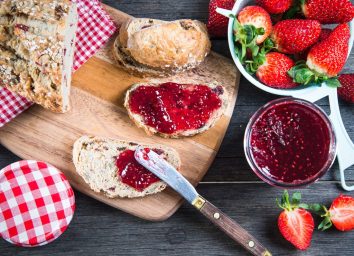Bread gets a bad rap when it comes to weight loss, but the truth is enjoying a slice or two can be good for you if you choose the right kind. Following some healthy shopping guidelines for buying bread, like sticking to whole-grain varieties that are low in sugar, will help ensure you're getting the best nutrition. We'll toast to that! Here are the top tips for finding the best bread.
Remember that carbs aren't all bad
Complex carbs that are high in fiber — like whole grains — actually aid in weight loss. Because fiber digests slowly, you'll feel fuller longer and will be less inclined to snack on junk foods high in sugars and trans fats. Refined grains strip the bran coat and endosperm, aka the most nutritious parts of a whole grain, so they don't provide as many nutrients as you'd get from whole grains. Moreover, whole grains keep your blood sugar levels stabilized.
Just be careful when selecting a brand — most bread in the sandwich aisle have high fructose corn syrup or a blend of whole and enriched wheat. Look for the "100 percent whole grain" label and read the ingredient list on the back to make sure the first ingredient is "whole grain" and check if there are any traces of refined grains or white flour. Many high-fiber bread brands are actually found in the freezer section because they spoil faster than the processed ones.
Choose Ezekiel bread
Ezekiel bread is an excellent choice because it's high in fiber and protein. One slice is 80 calories and has three grams of fiber and four grams of protein. Bonus: Zero sugar.
"When you're reading the ingredient list you should be looking for the word 'whole grain.' This means that the grain is still intact and hasn't been processed and essentially re-fortified," says Jessica Crandall, a registered dietitian in Denver, CO. The very first ingredient on Ezekiel loaf is 100% whole wheat (a type of whole grain), which indicates that it contains more fiber and offers more health benefits as a result. Whole grains have been found to reduce your risk for heart disease, diabetes, and other chronic diseases. For more suggestions, check out these 19 Best and Worst Breads for Weight Loss!
Pair it with protein
Protein and complex carbs are a winning weight-loss combo because they both increase satiety. Protein is a key macronutrient for building lean muscle and burning fat. The more lean muscle you have, the more fat you burn. Avoid deli meats like salami, ham, and roast beef because they pack sodium, fillers and other additives. Instead, go for low-sodium turkey breast and canned tuna. Both of them are protein-rich and keep you full way past the 3 p.m. afternoon slump.
Work bread into a fat-burning breakfast
From avocado toast to peanut butter and bananas, bread makes an excellent base for a nutritious breakfast. The fiber and protein in bread will energize you to start your morning and help your body burn fat all day long. Try a breakfast pizza with an egg on top or hummus toast with avocado slices and uncured turkey bacon strips. Check out 18 High-Protein Breakfasts That Keep You Full for more morning meal ideas.
A high-protein breakfast can be one of the most powerful tools in your weight-loss arsenal. One study of overweight adults found that those who ate a 350-calorie breakfast with 35 grams of protein (about six eggs' worth) consumed 26 percent fewer calories at lunch than those who consumed the same amount of calories at breakfast with less protein! Getting 35 grams of protein can be tough, but you can reap many of the same benefits with 20 grams.








